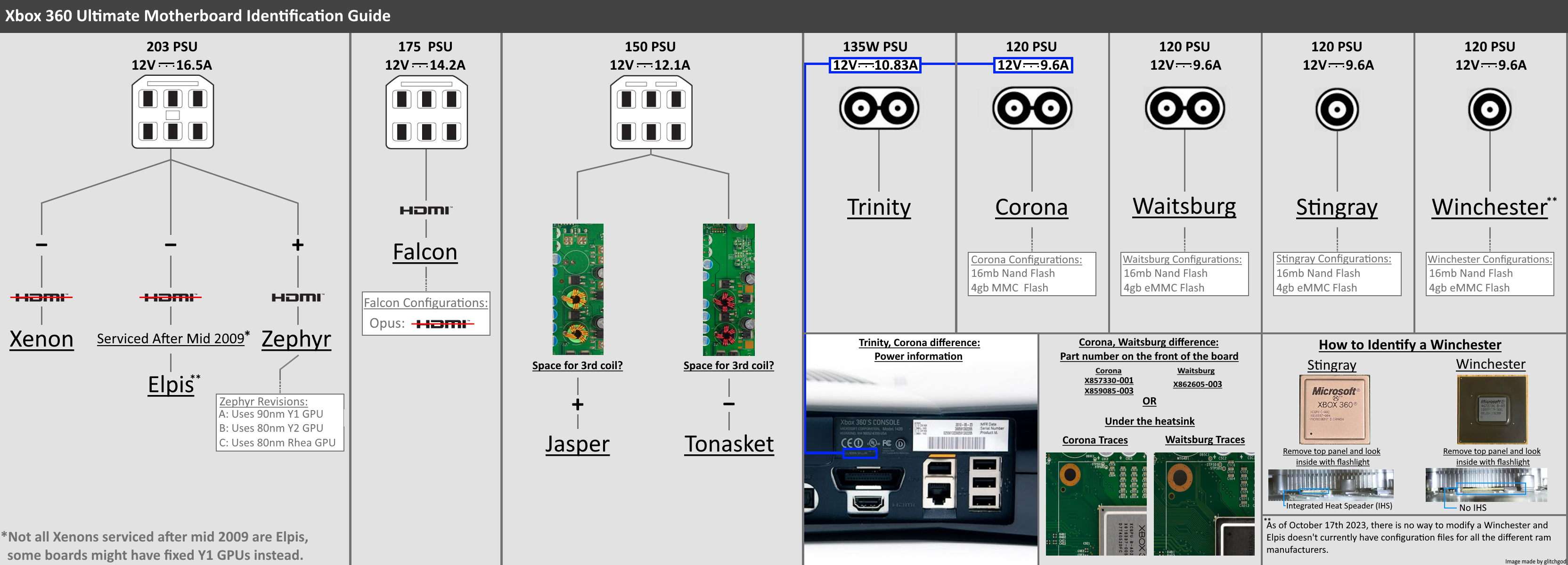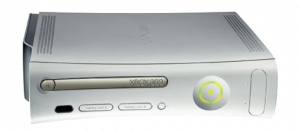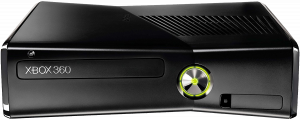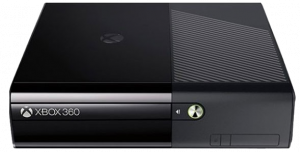Xbox 360:Getting Started: Difference between revisions
mNo edit summary |
m (minor edit) |
||
| Line 58: | Line 58: | ||
In Q1 2012, Microsoft revised the Corona motherboards to Waitsburg motherboards and removed the traces for the POST_OUT solder pad. This means you need to use [[:File:5lY3TID.png|a postfix adapter]] on the XCGPU in order to have access to RGH, but are otherwise very similar to Corona. | In Q1 2012, Microsoft revised the Corona motherboards to Waitsburg motherboards and removed the traces for the POST_OUT solder pad. This means you need to use [[:File:5lY3TID.png|a postfix adapter]] on the XCGPU in order to have access to RGH, but are otherwise very similar to Corona. | ||
Slims can use [[Xbox_360:RGH|most RGH methods]], but cannot use R-JTAG/JTOP or the original JTAG since their motherboards have no JTAG headers, and the CB in Slim CPUs patched JTAG by that point anyway. They also cannot use RGH 1 or EXT_CLK. | Slims can use [[Xbox_360:RGH|most RGH methods]], but cannot use R-JTAG/JTOP or the original SMC JTAG exploit since their motherboards have no JTAG headers for the GPU, and the CB bootloader in Slim CPUs patched JTAG by that point anyway. They also cannot use RGH 1 or EXT_CLK. | ||
Slim DVD drives are flashable if they came with a Lite-On DG-16D4S (these usually came with Trinity consoles and some early Coronas), but if they have a Hitachi DL10N (uncommon, but could come with any Slim/E motherboard) or DG-16D5S (usually Corona slims and most 360 E's) you need to buy an aftermarket DVD drive PCB and RGH the console to get the DVD key. The PCB in Lite-On drives also have some of the wires soldered to the PCB, but the Hitachi drives instead have ribbon cables for all connections so replacing a Hitachi board is easier. | Slim DVD drives are flashable if they came with a Lite-On DG-16D4S (these usually came with Trinity consoles and some early Coronas), but if they have a Hitachi DL10N (uncommon, but could come with any Slim/E motherboard) or DG-16D5S (usually Corona slims and most 360 E's) you need to buy an aftermarket DVD drive PCB and RGH the console to get the DVD key. The PCB in Lite-On drives also have some of the wires soldered to the PCB, but the Hitachi drives instead have ribbon cables for all connections so replacing a Hitachi board is easier. | ||
Revision as of 11:57, 12 August 2023
Over the years, Xbox 360 consoles have had several motherboard revisions. It is important to identify the motherboard revision to see what exploits are compatible and work best with your console. The steps for the mod itself will also vary depending on the motherboard. The easiest way is to look at the motherboard's PSU connector (phat) or required amprage (phat or Slim).
Identifying Your Motherboard
Power Supply Chart
Identifying a Built-in Memory Unit
Some Xbox 360 consoles come with a built in memory unit, which makes NAND backups require slightly different steps. You may want to back up any data on the memory unit, either in the dashboard or during a NAND dump. (Trinity slims came with a memory unit which was on a daughterboard, and the main NAND is 16MB like most motherboard revisions.)
You can see if a console has a built in memory unit by going in Settings > System Settings > Storage in the dashboard:
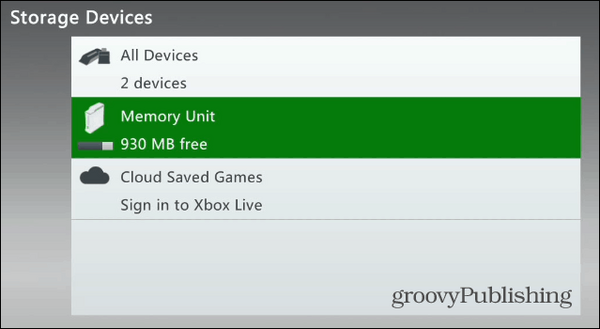
If you have a Slim or E model with a Corona motherboard, you can also determine if it has a 4GB eMMC memory unit by looking at the flash chip:
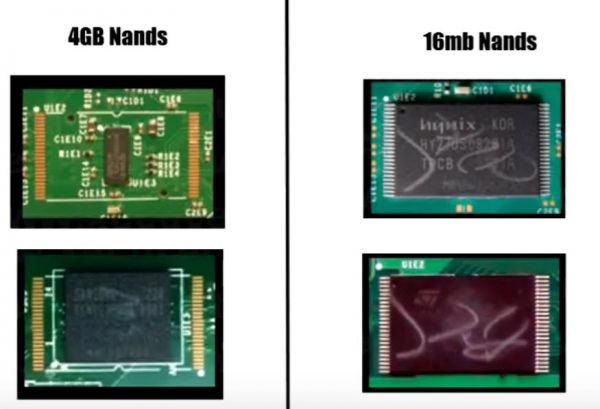
Identifying an Xbox 360 E's Motherboard
Unfortunately, the Xbox 360 E doesn't have a way of checking the motherboard revision without at least partially tearing down the shell.
However, you can take a shortcut by removing the top side panel next to the Wi-Fi card and look through the metal housing with a flashlight:
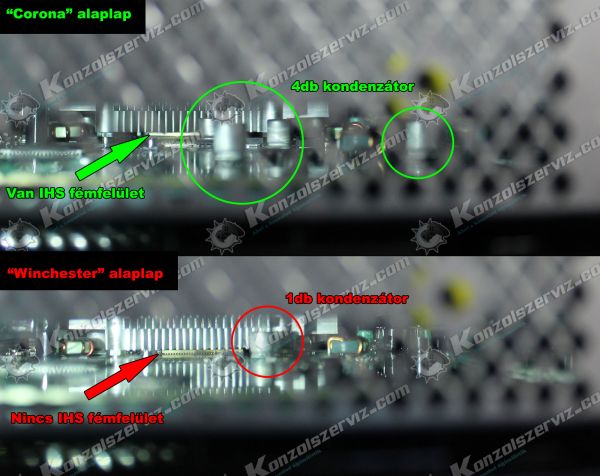
Xbox 360 ("phat")
Phat consoles with a white DVD tray and no HDMI were Xbox 360 Core models and shipped with Xenon boards and no hard drive or memory unit.
There were also Xbox 360 Arcade consoles, which had the white DVD tray like the Core but also had HDMI. Early Arcade consoles came with a Falcon motherboard and an external memory unit, but Jasper Arcades also had a larger 256MB (later changed to 512 MB) NAND to have a built in memory unit. They also didn't come with a hard drive. You can also see if a phat Xbox 360 has an internal memory unit by going in System Settings > Storage in the dashboard.
Consoles with chrome DVD trays originally shipped with a hard drive. They can include various motherboards with or without HDMI, and with a 16 MB NAND.
Retail Xenons, Zephyrs, and Falcons always have a 16 MB NAND. Phat developer consoles instead have a 64 MB NAND including Jaspers.
If your console is running dashboard/kernel 2.0.7371 or lower, it will have access to the JTAG exploit. However, some consoles with 7371 were patched against the JTAG exploit, in which case their CB needs to be checked after a NAND dump.
If your console's dashboard/kernel is above 2.0.7371 and has a patched CB, you can use various RGH methods. 2.0.14699 and lower on Phats have access to RGH 1, but anything newer can use RGH 1.2, RGH 2 (non-Xenon), RGH 3, and on Xenon/Zephyr, EXT_CLK.
Any DVD drive in a phat console can be flashed without soldering. However, the Lite-On DG-16D2S requires a probe tool.
R-JTAG requires dashboard/kernel 2.0.14719 or higher, and R-JTOP requires dashboard/kernel 2.0.15572 or higher.
Xbox 360 Slim
Early slims with a glossy case came with a Trinity board and hard drive, but ones that came with a 4GB memory unit came with a matte case. Later on, Trinity consoles that shipped with hard drives were also switched to a matte case. Corona/Waitsburg consoles were always matte.
4GB Trinity slims had the memory unit on a daughterboard with the main NAND still being 16 MB. 4GB Corona/Waitsburg slims instead had the eMMC built onto the board as the main NAND, thus making NAND dumps require different tools and steps.
Trinity motherboards can be easily distinguished from Corona/Waitsburg motherboards by looking near the AV port to see if it has a HANA chip.
Corona has the HANA chip integrated in a new south bridge, which is another way to tell. This is a Trinity's south bridge.
The Trinity boards will also have the J2C3 header vertically orientated.
Trinity devkits have a 512 MB NAND like Arcade Jaspers, but Corona devkits have a 4 GB eMMC like retail versions.
In Q1 2012, Microsoft revised the Corona motherboards to Waitsburg motherboards and removed the traces for the POST_OUT solder pad. This means you need to use a postfix adapter on the XCGPU in order to have access to RGH, but are otherwise very similar to Corona.
Slims can use most RGH methods, but cannot use R-JTAG/JTOP or the original SMC JTAG exploit since their motherboards have no JTAG headers for the GPU, and the CB bootloader in Slim CPUs patched JTAG by that point anyway. They also cannot use RGH 1 or EXT_CLK.
Slim DVD drives are flashable if they came with a Lite-On DG-16D4S (these usually came with Trinity consoles and some early Coronas), but if they have a Hitachi DL10N (uncommon, but could come with any Slim/E motherboard) or DG-16D5S (usually Corona slims and most 360 E's) you need to buy an aftermarket DVD drive PCB and RGH the console to get the DVD key. The PCB in Lite-On drives also have some of the wires soldered to the PCB, but the Hitachi drives instead have ribbon cables for all connections so replacing a Hitachi board is easier.
- DG-16D4S drives with MXIC flash need a probe tool like the phat D2S, but uses a different type of probe tool. It must be a probe tool for a Slim 16D4S. Do not use a probe tool intended for a 16D2S and vise versa.
- Some DG-16D4S drives come with a "Windbond" flash chip (example) which requires the infamous Kamikaze mod in order to flash custom firmware. It involves drilling a specific area on the chip to unlock write permissions.
Xbox 360 E
Just like the Slim, the 360 E also came with 16MB NAND (with hard drive) or 4GB eMMC SKUs. The flash type can be identified the same way as the 360 Slim motherboards, either by looking at the flash chip or in the dashboard.
Winchester boards can be differentiated from Corona boards by looking through the side vent with a flashlight or by looking at the motherboard/XCGPU itself. Winchester boards have much less components on them, and there's no outline around the XCGPU. The Winchester XCGPU also doesn't have an IHS. Consoles with a manufacture date of 07-2014 and AFTER are likely to be the non-modable Winchester motherboard. However, the manufacterer date won't guarantee the motherboard revision unless it's from 2015 or 2016, which is almost always gonna be a Winchester.
Corona motherboards in the 360 E (Stingray) are slimilar to Corona/Waitsburg motherboards in Slims, but with some features cut to have a lower price point for the console. Thus they also need a postfix adapter and have the same RGH methods available.
DVD drives in Xbox 360 E's are usually a DG-16D5S, which are not flashable and the DVD key cannot be extracted. The same applies to the Hitachi DL10N. It is possible to get the DVD key with RGH, but flashing requires a PCB replacement. Slim Hitachi drives don't have any wires soldered to the PCB, however.
Winchester boards are not exploitable in any way. This includes RGH/JTAG, drive flashing, and ODEs.
Choosing what kind of hack to use
RGH/JTAG
| R-JTAG requires an R-JTAG chip or CR4 XL which aren't sold anymore, and tends to have slow boot times compared to RGH 1.0/1.2/3/S-RGH or R-JTOP. Thus, this specific exploit is not recommended over RGH/R-JTOP. |
- Various Reset Glitch Hack or JTAG methods will fully unlock the console for homebrew, emulators, digital game backups, region free DVD movies/games, etc.
- Hacks that fully unlock the console like RGH or JTAG require soldering, and there is no software alternative.
- If you want to know which RGH/JTAG method to use, see the recommended exploit chart to determine the best hack for your model or dashboard.
DVD Drive Flashing
- An Xbox 360 with a DVD drive flashed with custom firmware will allow you to play retail game backups with burned DVDs, but will not allow access to homebrew, emulators, game mods, backups of digital games, or even a region unlock.
- However, DVD drive flashing with a phat or Slim DG-16D4S DVD drive does not require any soldering unlike JTAG or the Reset Glitch Hack.
Optical Disc Emulator
- The Xbox 360 had a few optical disc emulators released for it, such as the XK3Y ODE, Wasabi360, and Boxzii. These devices allowed you to play .iso dumps of retail games through USB or eSATA storage.
- ODEs have not been manufactured in a long time, and were expensive. Similarly to a flashed DVD drive, these didn't unlock the console for unsigned software and were only used for playing disc backups. They tend to not be very common on the used market either.
King Kong Exploit
| This hack is not recommended as it is very limited and only for very old dashboards. It is just listed here for completeness. |
- The King Kong Exploit used a modified copy of Peter Jackson's King Kong to allow the Xbox to boot into a Linux distribution. The KK exploit didn't allow access to homebrew outside of Linux.
- This exploit did not permanently modify the console's operating system, and the game had to be loaded every time you wanted to use Linux. Since you needed to boot into a game backup, the DVD drive needed to be flashed as well.
- The King Kong Exploit only worked on consoles with a 2.0.4532 or 2.0.4548 kernel/dashboard, and there's no method to downgrade a retail Xbox 360 to a kernel vulnerable to the KK exploit due to the CPU's eFuses.
